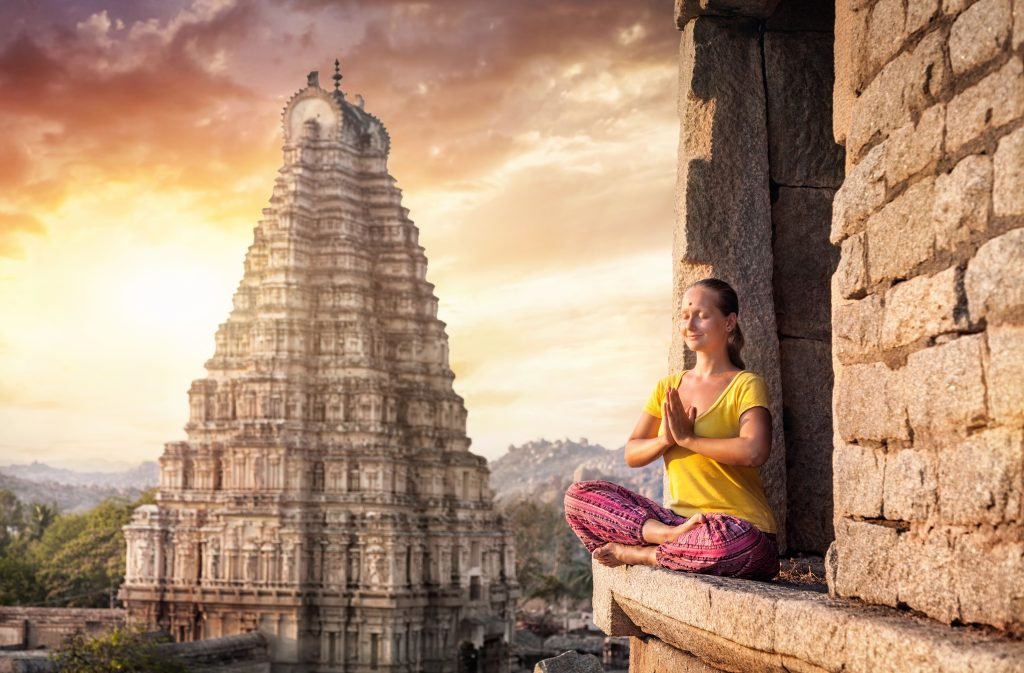Sadhana Pada Chapter 2 Explained - Patanjali's Yoga Sutras

In the second chapter of Yoga Sutras, Sage Patanjali speaks about the path and practices it takes to reach the highest state, in the life of a spiritual seekers goal.
The first chapter in Yoga Sutras is followed by ‘Sadhana Pada’, the path of spiritual practices expected to be performed by a seeker of liberation.
These spiritual practices are external & internal ones, through which one can get a command over the mind.
This chapter is primarily meant for the spiritual seeker aiming for the ultimate liberation in life.
The primary objective of this chapter is to explore Kriya and Ashtanga yoga practices.
Sage Patanjali explains how Ashtanga yoga needs to be practiced externally.
Scientifically, every human being has inborn psychological imbalances, called as kleshas.
Sage Patanjali explains how its impressions can be erased through the practices in Kriya Yoga.
He proves that a spiritual seeker can reach the state of Samadhi only with the elimination of these mental imbalances.
First among five of those is the ignorance in an individual to identify the real and unreal or mistaking the non-eternal to be eternal.
Because of this ignorance, he thinks himself as intellectually great with ego.
With this attitude arises the pleasure, seeking external objects to be mistakenly taken as the ultimate ones leading to attachment.
If there is pleasure, naturally the opposite too will arise. The opposite is the aversion towards the pain creating situations or objects.
Patanjali says that the survival instinct that is inborn in humans is the most subtle, dormant, and challenging impression to tackle.
These kleshas manifests through 4 different states or stages, says Patanjali.
These are the dormant, attenuated, manifest & overpowering states.
Ancient scriptures always have emphasized the cause and effect relationship which is otherwise called as law of karma.
It is as simple as “whatever you do to others, returns in similar or a different form”.
Patanjali says these karmas bind us to the loop of birth and death.
Once you realize that the world is mundane, then only the path of yoga starts.
The importance of these practices in life is also understood at this point.
After talking about the psychological afflictions and its manifestations, he talks about the way for seekers to come out of this karmic cycle.
When a seeker realizes that the worldly pleasures are painful and it is not the real one, then he starts thinking from an intellectual discriminative point of view.
It is at this point when he starts differentiating the real and unreal.
He understands that the cause of suffering is because of thought that the individual is the Self and there is nothing beyond.
Sorrows will always continue in life and it is necessary to have precautionary measures taken to ensure that the mind never goes into delusion.
In Patanjali’s Yoga Sutras, Kaivalya is the highest state giving one the real blissful experience. It is called “Anandam”.
Buddha also preaches on the same lines stating that the experiences from the world can bring suffering and one has to learn how to overcome it.
Patanjali continues to preach saying the seeker has always to think ahead of time, expecting to face the miseries.
The suffering will continue to manifest in the future too.
The basic mistake is ignorance of the fact that the one who experiences the sufferings and the experiences themselves are the same.
In other words, the experienced and experiences are both separate.
It is for the individual to realize how to perceive these experiences in life and react to it. The ignorance is called by scriptures as “Avidya” or the ignorance of reality.
Inborn qualities manifested in an individual are Stithi or stable inertness (Tamas), Kriya or dynamic action (Rajas), and Prakasha or illumination (Satvic). These are gunas or qualities.
One has to understand that the very goal of practicing Yoga Sadhana is to erase the impurities through the understanding of one’s own mind with the help of these limbs.
With this sustained, dedicated practice alone one can reach or experience the wisdom of enlightenment.
Followed by these is the eight folded royal path or “Ashtanga Yoga”.
Ashta in Sanskrit means eight.
Ending with Samadhi, the eight fold path is: “yama niyama asana pranayama pratyahara dharana dhyana Samadhi”.
It is then followed by 2 sets of 5 rules – Yamas & Niyamas.
It starts with yamas, the five principles that help the seeker to obtain control over the lower, nature and organs, making him humane. These are:
- Ahimsa – Non Violence, control of the thoughts with violent nature
- Satya – Truthfulness, overcoming of lying tendencies
- Asteya – overcoming thieving tendencies
- Brahmacharya – command over creative energies
- Aparigraha – controlling of possessive tendencies
Pancha Niyama – the five ethical observances to enhance humane qualities preparing for the higher, conscious life of Yoga.
- Saucha – cleanliness at all levels – internally & externally
- Santhosha – self contented happiness
- Tapa – disciplined efforts to reach the goal
Swadhyaya – introspection & self-analysis - Ishwara Pranidhana – Ishwara is considered as the divinity higher to humans.
- Pranidhana – the ability to surrender one’s will, after making one’s best efforts. The surrender is towards Ishwara.
Sage Patanjali continues to advise through his sutras to imbibe Pratipaksha Bhavanam, opposite views when one is facing negative thoughts arising out of adverse situations.
This will pull down the seeker from evolution.
Negative or adverse state in the mind may be because of following reasons:
Our own actions which are direct. They are called as krita.
Committed by others because of us, called as karita.
Some are condoned by us – anumodita.
Other factors for root cause of negative actions – greed, anger or delusion.
As the practice continues, the seeker will accomplish psychic capacities that can be manifested.
Yama and Niyama practices are as follows:
- Ahimsa – cessation of hostility in the life and presence of seeker
- Satya – truthfulness
- Asteya – positivity will be attracted towards the seeker
- Brahmacharya – celibacy
- Aparigraha – knowledge of past and present life
- Saucha – one-pointedness, sense control and vision of the inner self
- Santhosha – happiness and peace
- Tapa – austerities
- Swadhyaya – Contemplation on the self
- Ishwara Pranidhana – Godliness or the divinity
Patanjali elaborates the next limb in Ashtanga Yoga, Asana as “sthira sukham asanam”. Any comfort posture in yoga practice is the best one.
Sthira is stability, sukham is the happiness or peace and asana is the posture. Asana is a state in physical and mental place that radiates stability and ease.
Asana practices gives the seeker the experience of harmony in the body.
Focusing on the breath is the important factor in the asana practice.
Once the body movement is synchronized with the inhalation and exhalation in breathing process, then the seeker has to moves to the next limb, pranayama.
It is the link in the humans, connecting between the external and internal worlds.
It is something to be practiced by the seeker to evolve in the spiritual path.
Retention of the air while breathing is something that needs to be practiced for a longer time.
Important fact is that to withdraw the senses and the mind from the external world and pleasure, he goes on to define Pratyahara.
One will be able to manage and balance the emotions without losing the harmony.
A sincere seeker must have found the way out and is ready to move to the next stage in the inner journey.
You might also enjoy

Las Vegas Paris Hotel Luck Of The Draw – Room Review!
Paris Hotel – Luck Of The Draw Room Review! – Was it Worth It? Las Vegas: Paris Hotel Luck Of The Draw Gamble! If you’re

Married at First Sight Season 17: The Denver Disaster
Married at First Sight Season 17: The Denver Disaster Let’s Talk About Married at First Sight Season 17: After binge-watching the entire season of Married

YOU ARE Positive Affirmations to Change Your Life (LISTEN TO Affirmations)
YOU ARE Positive Affirmations to Change Your Life (LISTEN TO 50 AM/PM Affirmations) Welcome, beautiful souls! Today, we are going to embark on a journey

50 ‘YOU ARE’ Powerful Daily Affirmations to Start Your Day!
50 ‘YOU ARE’ Powerful Daily Affirmations to Start Your Day! Are you ready to transform your mornings with powerful affirmations that can change your entire

50 I AM Prayer Affirmations: God Says I AM
50 Powerful ‘I AM’ Prayer Affirmations: God Says I AM Welcome! Today, we want to remind you that God is always with you, guiding you,

50 Quit Vaping Nicotine Affirmations (Reprogram Your Thoughts)
50 Quit Vaping Nicotine Affirmations (Reprogram Your Thoughts) It’s Time To Reprogram Your Thoughts for the Better! Did you know that vaping among young adults





